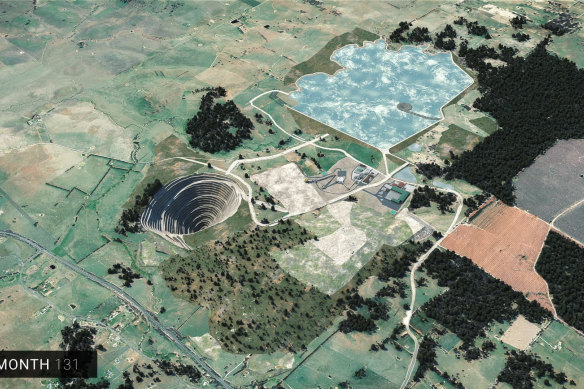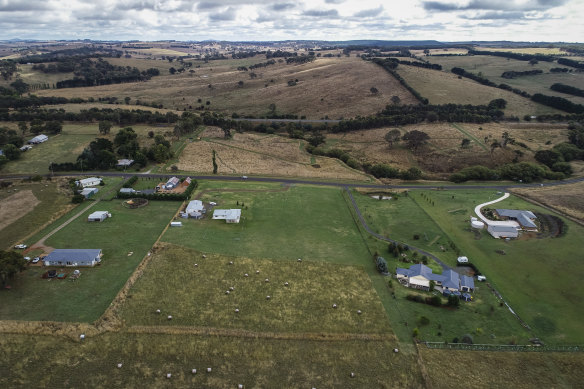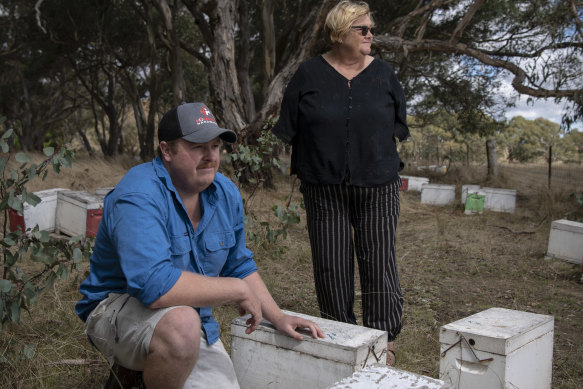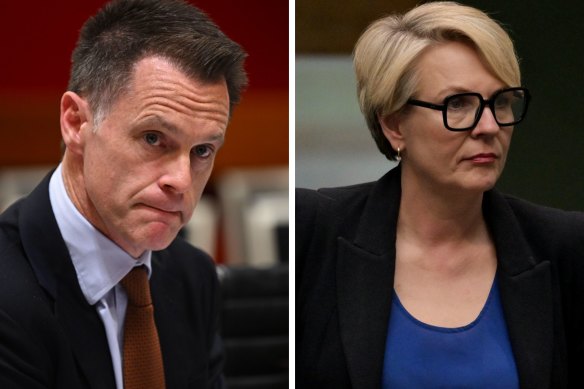- Analysis
- Environment
- Conservation
- Mining
This was published 7 months ago
Lies, damned lies and gold mines: What you need to know about the Blayney bunfight
The little town of Blayney, near Orange in the NSW Central West, is no stranger to a gold rush.
Although the Blayney-Kings Plains area was extensively dug out in the 1850s, there is plenty of ground left for a company with plans to build a gold mine.
The McPhillamys mine, proposed by Regis Resources, has become a political football since federal Environment Minister Tanya Plibersek decided to block a key part of the project.

An illustration of the McPhillamys mine, with Kings Plain houses in the bottom left.Credit: Regis Resources
Specifically, Plibersek rejected the location of the tailings dam – a storage facility for the mining waste – on the headwaters of the Belubula River. She did this not on environmental grounds, but because of Indigenous cultural heritage.
Sections of the media , including The Daily Telegraph, 2GB and Sky News, have been up in arms ever since. This week NSW Premier Chris Minns entered the fray, saying he was “disappointed” by Plibersek’s decision and defending the initial NSW approval.
Environmental grounds
That does not mean the environmental impact is benign. The Belubula is home to platypus, provides water to neighbouring farms and flows into the Carcoar Dam, used for recreation. It eventually joins the Lachlan River, part of the Murray-Darling basin.
Building a dam means plugging up springs that feed the river. The company’s own environmental impact statement admits there will be seepage. If the dam wall collapses, it would be catastrophic.
The project has passed the NSW planning system, and Plibersek approved it under the Environment Protection and Biodiversity Conservation (EPBC) Act, causing some to ask whether NSW and federal planning and environmental laws adequately protect nature.

Residential properties across the road from the proposed gold mine.Credit: Wolter Peeters
An independent, once-in-a-decade review of the EPBC Act by businessman Graeme Samuel called for strengthening of federal environmental protections. There are similar criticisms of NSW planning law.
Can the mine go ahead?
Plibersek insists the mine can still go ahead. She is technically correct that she approved the mine, but her dam decision puts the project’s viability in serious doubt.
The mine cannot be built without waste storage. There are other potential sites for the dam, and Regis Resources has confirmed to the NSW government it will continue to explore these options.
Regis argues identifying a new site and getting it approved will take five to 10 years. However, the NSW government has promised to fast-track the process.

Bee and honey producers Vicky and Sam Lockwood adjoin the proposed mine and oppose its construction.Credit: Wolter Peeters
Moving the dam will cost money, and the estimated cost for the mine has already blown out to nearly $1 billion – expensive for a project only expected to produce 2 million ounces of gold.
The company has been looking for a joint venture partner to reduce its financial risk. Its share price has soared since Plibersek made her decision.
What are the Indigenous concerns?
Plibersek found the damage to the headwaters of the river was unacceptable because of the significance of the site and the river to the local Indigenous people.
She upheld a Section 10 application by Wiradjuri-Gamillaroi woman Nyree Reynolds on behalf of the Wiradyuri Traditional Owners Central West Aboriginal Corporation.
Some commentary has mocked the fact Reynolds belongs to two mobs. Yet, Aboriginal people inherit heritage from both parents, just like everyone else.

NSW Premier Chris Minns and federal Environment Minister Tanya Plibersek are at odds over a proposed gold mine in the NSW Central West.Credit: Janie Barrett; Getty
The issue of who gets to speak on behalf of Indigenous people is tricky, but the standing of the Wiradyuri traditional owners’ group was also recognised by the former Coalition government when then environment minister Sussan Ley rejected another project opposed by the same group under the same laws.
Minns says the NSW planning process involved consultation with the Orange Local Aboriginal Land Council.
The Orange land council originally opposed the mine, arguing in its 2019 submission it would “detrimentally and irreversibly impact the Aboriginal [and shared] cultural heritage significance”. In 2023 it changed its stance to “neutral”.
Land councils are established entities in NSW law, elected by any Indigenous people living within boundaries defined by the government, but many Aboriginal people say they do not always represent traditional owners.
Minns argues it is important for NSW to diversify from coal, but it is a stretch to paint the McPhillamys project as critical to the NSW economy. Regis Resources estimates the mine will employ 200 people; by comparison 1400 workers are employed at the nearby Cadia gold mine. Regis says McPhillamys will pay royalties to the state of $65 million in net present value or “potentially” $200 million based on inflation and the forecast price of gold.
State v federal
Minns keeps pressing the point that the project passed the NSW planning system, implying that it should also have been approved by the federal government.
The reason the federal environment minister is the final decision-maker is that states had such a terrible track record on the environment that the Howard government intervened and passed the Environmental Protection and Biodiversity and Conservation Act back in 1999.
As Minns’ colleague, NSW Environment Minister Penny Sharpe, said in estimates on Thursday, the state has its legislation and the federal minister has hers. Both have to be upheld.
Cut through the noise of federal politics with news, views and expert analysis. Subscribers can sign up to our weekly Inside Politics newsletter.